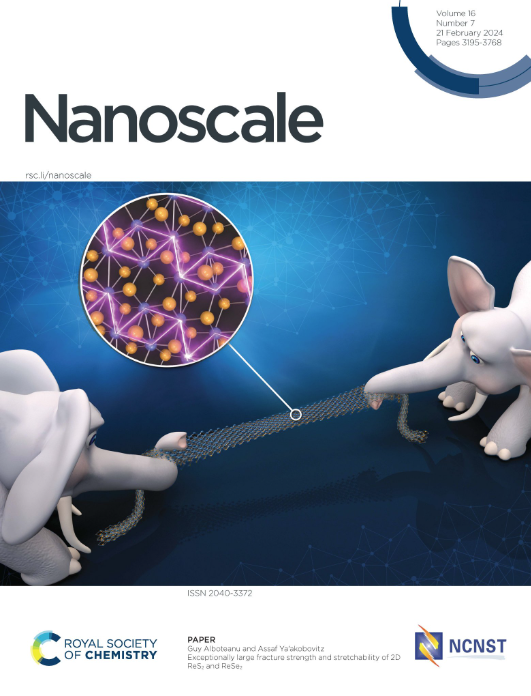高岭土纳米管作为疏水全氟卟啉基光敏剂的载体用于单线态制氧
IF 5.1
3区 材料科学
Q1 CHEMISTRY, MULTIDISCIPLINARY
引用次数: 0
摘要
有效给药系统的发展代表了癌症治疗的重大进步。各向异性、天然且具有成本效益的纳米载体,如高岭土纳米管(HNT),可用于此目的。在本研究中,我们将极性光敏剂(PS) 5,10,15,20-四(全氟苯基)卟啉(H2TPPF20)及其Zn(II)配合物(ZnTPPF20)装载在HNT上,以产生用于光动力治疗(PDT)的单线态氧。负载是通过重复真空/N2循环实现的,使用原始HNT和用十四烷基膦酸修饰的HNT (HNT- tdp)来促进内腔对亲脂性PS的吸收。为了减缓纳米管中PS的释放,我们对纳米管进行了糊精处理。用低功率可见LED发射器(23 mW/cm2)照射样品,证实了自由碱和锌全氟卟啉产生单重态氧(1O2)的能力,在乙醇中显示出1O2的量子产率分别为22%和34%。纳米复合材料的表征不是简单的,所以我们采用了广泛的分析技术来彻底研究材料,特别是PS在HNT中的位置。采用衰减全反射红外光谱(ATR-FTIR)、漫反射光谱(DRS)和固态发射光谱对所有纳米杂化物进行分析。热重分析(TGA)测定了HNT的承载能力。为了更好地理解PS与纳米粘土之间的相互作用,我们将所有负载的HNT样品与机械混合的HNT样品和固体H2TPPF20或ZnTPPF20样品进行了比较,其中假设没有与HNT内腔的相互作用。最后,通过共聚焦显微镜研究了三种不同肿瘤细胞系对原始HNT和负载样品(HNT- tdp - h2tppf20 -糊精)的细胞摄取情况。然后评估PC3、5637和UMUC3细胞的细胞毒性,将细胞置于黑暗中和用可见光发光LED (1.3 mW/cm2)照射,以降低细胞活力,确定诱导细胞死亡的能力,特别是在光照后。本文章由计算机程序翻译,如有差异,请以英文原文为准。
Halloysite nanotubes as a vector for hydrophobic perfluorinated porphyrin-based photosensitizers for singlet oxygen generation
The development of effective drug delivery systems represents a significant advancement in cancer treatment. Anisotropic, natural, and cost-effective nano-vectors, such as Halloysite nanotubes (HNT), can be utilized for this purpose. In this study, we loaded the HNT with the apolar photosensitizers (PS) 5,10,15,20-tetrakis(perfluorophenyl)porphyrin (H2TPPF20) and its Zn(II) complex (ZnTPPF20) to produce singlet oxygen for photodynamic therapy (PDT). The loading was achieved through repeated vacuum/N2 cycles using both pristine HNT and HNT modified with tetradecylphosphonic acid (HNT-TDP) to promote the uptake of the lipophilic PS in the inner lumen. To slow the release of PS from HNT, the nanotubes were treated with dextrin. The ability of the free base and Zn perfluorinated porphyrins to produce singlet oxygen (1O2) was confirmed by irradiating the samples with a low-power visible LED emitter (23 mW/cm2), showing a 1O2 quantum yield of 22 % and 34 %, respectively, in ethanol. The characterization of the nanocomposite is not trivial, so we employed a wide range of analytical techniques to investigate the material thoroughly, particularly the location of PS within the HNT. All nano-hybrids were analyzed by Attenuated Total Reflectance Infrared (ATR-FTIR), Diffuse Reflectance (DRS) and solid-state emission spectroscopies. Thermogravimetric analysis (TGA) was used to determine the loading capacity of HNT. To better understand the interactions between the PS and the nanoclay, we compared all the loaded HNT samples with mechanically mixed HNT and solid H2TPPF20 or ZnTPPF20 samples, where the interaction with the HNT inner lumen is assumed to be absent. We measured the release kinetics using UV-vis spectroscopy, observing a delayed release of the PS. Finally, we firstly studied the cellular uptake of pristine HNT and a loaded sample (HNT-TDP-H2TPPF20-dextrin) by confocal microscopy by three distinct tumor cell lines. The cytotoxicity on PC3, 5637 and UMUC3 cells was then assessed as reduction of cell viability both on cells left in the dark and irradiated with a visible light emitting LED (1.3 mW/cm2), ascertaining the ability to induce cell death especially after light administration.
求助全文
通过发布文献求助,成功后即可免费获取论文全文。
去求助
来源期刊

Nanoscale
CHEMISTRY, MULTIDISCIPLINARY-NANOSCIENCE & NANOTECHNOLOGY
CiteScore
12.10
自引率
3.00%
发文量
1628
审稿时长
1.6 months
期刊介绍:
Nanoscale is a high-impact international journal, publishing high-quality research across nanoscience and nanotechnology. Nanoscale publishes a full mix of research articles on experimental and theoretical work, including reviews, communications, and full papers.Highly interdisciplinary, this journal appeals to scientists, researchers and professionals interested in nanoscience and nanotechnology, quantum materials and quantum technology, including the areas of physics, chemistry, biology, medicine, materials, energy/environment, information technology, detection science, healthcare and drug discovery, and electronics.
 求助内容:
求助内容: 应助结果提醒方式:
应助结果提醒方式:


